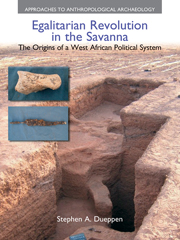Book contents
- Frontmatter
- Dedication
- Contents
- List of Figures
- List of Tables
- Acknowledgments
- 1 Decentralization and the Evolution of Egalitarian Behaviors in Sedentary Societies
- 2 Ancient Villages in the Niger Bend: Context and Methods for Exploring the Voltaic Region
- 3 Ethnographic Perspectives on Western Burkina Faso: A Survey
- 4 Kirikongo: An Introduction to the Site, the Setting, and the Research Design
- 5 The West African Environmental Setting: Kirikongo in Ecological Context
- 6 Stratigraphies and Depositional Episodes: The Excavations
- 7 Relative Chronology: Ceramics
- 8 Community Growth at Kirikongo: The Spatial and Temporal Setting
- 9 Early Sedentary Life in the Voltaic Region: Defining a ‘Voltaic Tradition’
- 10 Craft Production at Kirikongo: The Origins, Development and Reinterpretation of Specialization
- 11 Herding, Farming, and Ritual Sacrifice: The Economy from Kirikongo
- 12 Death and Ritual Objects at Kirikongo: House-Based Social Differentiation
- 13 Archaeological Patterns and Social Process: Reconstructing Changing Life at Kirikongo
- 14 Land, Spiritual Power, and Gerontocracy: An Exploration of the Roots of Egalitarian Revolution in the Western Voltaic Region
- 15 Hierarchy and Egalitarianism within the Niger Bend: Revolution and the Triumph of Communalism
- Bibliography
- Index
10 - Craft Production at Kirikongo: The Origins, Development and Reinterpretation of Specialization
- Frontmatter
- Dedication
- Contents
- List of Figures
- List of Tables
- Acknowledgments
- 1 Decentralization and the Evolution of Egalitarian Behaviors in Sedentary Societies
- 2 Ancient Villages in the Niger Bend: Context and Methods for Exploring the Voltaic Region
- 3 Ethnographic Perspectives on Western Burkina Faso: A Survey
- 4 Kirikongo: An Introduction to the Site, the Setting, and the Research Design
- 5 The West African Environmental Setting: Kirikongo in Ecological Context
- 6 Stratigraphies and Depositional Episodes: The Excavations
- 7 Relative Chronology: Ceramics
- 8 Community Growth at Kirikongo: The Spatial and Temporal Setting
- 9 Early Sedentary Life in the Voltaic Region: Defining a ‘Voltaic Tradition’
- 10 Craft Production at Kirikongo: The Origins, Development and Reinterpretation of Specialization
- 11 Herding, Farming, and Ritual Sacrifice: The Economy from Kirikongo
- 12 Death and Ritual Objects at Kirikongo: House-Based Social Differentiation
- 13 Archaeological Patterns and Social Process: Reconstructing Changing Life at Kirikongo
- 14 Land, Spiritual Power, and Gerontocracy: An Exploration of the Roots of Egalitarian Revolution in the Western Voltaic Region
- 15 Hierarchy and Egalitarianism within the Niger Bend: Revolution and the Triumph of Communalism
- Bibliography
- Index
Summary
The relationship between the emergence of specialized craft production and social complexity has long been a topic of archaeological inquiry (e.g. Childe 1936; Evans 1978; Brumfiel and Earle 1987; Costin 1991; Clark 1995; Sinopoli 2003), as craft production constitutes a primary form of social differentiation in many societies. As was presented in the description of the cultural setting in Chapter 3, the organization of craft production varied greatly throughout the early twentieth century Voltaic region. Here I present data from Kirikongo on two of the most visible classes of crafts produced that leave behind a substantial archaeological record—ceramics and iron metallurgy, and describe the different trajectories leading to their respective specialized production.
Craft Specialization
On a most general level, Costin (1991: 43) defines specialization as ‘differential participation in specific economic activities. Whenever there are fewer producers than consumers of a particular good, we recognize specialized production.’ More specifically, she argues
specialization is a differentiated, regularized, permanent, and perhaps institutionalized production system in which producers depend on extra-household exchange relationships at least in part for their livelihood, and consumers depend upon them for acquisition of goods they do not produce themselves
(Costin 1991: 4).Perhaps a more widely applicable definition is that provided by Inomata (2001: 322) drawing on Clark (1995), which focuses solely upon the production end of the spectrum, without any implications for the producers status or the respective role of the rest of a community: ‘the production of alienable goods by a segment of the population for consumption outside the producer's own household’.
- Type
- Chapter
- Information
- Egalitarian Revolution in the SavannaThe Origins of a West African Political System, pp. 197 - 227Publisher: Acumen PublishingPrint publication year: 2012



